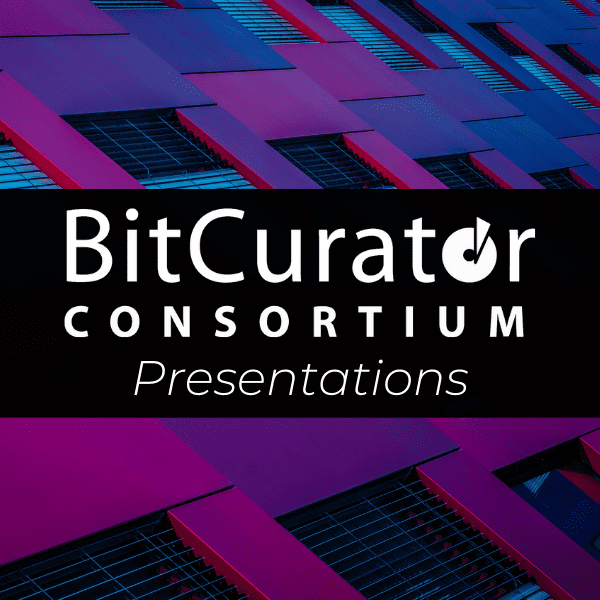Session 3: BitCurator
Arjun Sabharwal, Alison Rhonemus, Hannah Wang | BitCurator Consortium
Talk One: BitCurator Environments in Archives: Collaboration Architectures and Workflow for Digital Preservation (00:01:40)
Arjun Sabharwal
The demand for digital preservation has reached a new milestone with the growth of born-digital records. However, many public institutions and private organizations have not completely grasped the enormity of this challenge and are far away from a strategy for digital preservation, especially with the use of BitCurator. Archives and special collections units must consider their institutions’ technology infrastructure (technology support, storage, and collaboration space) as critical factors, which will significantly shape a digital curation initiative with collaboration architectures and workflows based on what such an infrastructure would allow. Collaboration architectures are structures evolving around teams, content, and technologies available. The installation of BitCurator indicates critical choices made in this matter by the department, parent units, and management.
Operating systems (OS) and storage environments are dominant factors for installation choices. Installing BitCurator is possible in two ways: on a dedicated workstation using Ubuntu OS and a virtual machine in a Windows OS environment emulating the Ubuntu OS. The storage of digital content will require much more dedication from institutions than what IT departments are willing to acknowledge or accept. Curators using either installation will be able to use the internal hard drives for confidential data in some records that cannot be shared. Networked drives, in contrast, can support sharing, collaboration, and restricted access. At the University of Toledo, The Ward M. Canaday Center for Special Collections has began evaluating the future use of BitCurator, and this presentation will focus on the technological infrastructure, collaboration architecture, and workflow models.
Talk Two: Scaling BitCurator (00:22:33)
Alison Rhonemus
Digital Archives workflows at NYPL employ a number of different tools from Siegfried and Bag-it to Bash and Python scripts written in-house. Workflows have evolved over the years and each computer in the lab has slightly different tools. We have some official scripts on GitHub but no consistent practice of maintaining changes on GitHub. This is not a recommended practice but the various locations of disparate scripts was not really a problem until I would need to work off-site for a long period of time. During the COVID-19 shutdown I needed to quickly assemble a workstation that would allow me to perform the functions of my daily digital archives work from home.
I am able to continue the kind of work I did in the office due to the robust set of tools available through BitCurator. Instead of reassembling my workstation I was able to use a BitCurator virtual machine to perform the same kinds of tasks as I used to do daily. This experience has also been a valuable opportunity to reevaluate our overall workflows and consider how we can use BitCurator to simplify and scale our current workflows. As we think about strengthening remote work infrastructure, BitCurator is a more scalable and suitable option.
Talk Three: Jargon of/and pedagogy: BitCuratorEdu project update and brainstorming activity (00:36:32)
Hannah Wang
The first half of the session will provide an update on the first two years of the BitCuratorEdu Project, which seeks to study and advance the adoption of digital forensics tools and methods in libraries and archives through professional education efforts. This update will summarize findings from the project survey and interviews, highlight learning modules created by the project team, and discuss upcoming work in the last year of the project.
The second half of the session will be a facilitated activity about the terminology that is used in teaching BitCurator and digital forensics. What terminology have you found particularly helpful in conveying your work to fellow staff, or in creating context for students or workshop participants? What are the key concepts and background that need to be conveyed to people starting out with BitCurator and other born-digital archiving tools? The goal of this activity will be to create a community-sourced vocabulary for working with and teaching about born-digital materials that can help inform the terminology implemented in the BitCuratorEdu curriculum.
Chat Log Slides
Arjun Sabharwal, Alison Rhonemus, Hannah Wang. (October 14, 2020). Session 3: BitCurator. BitCurator Consortium.